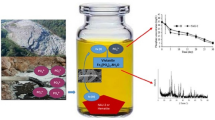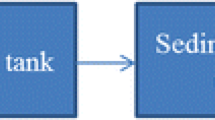Abstract
This study focuses on identifying the factors under which mixed microbial seeds assist bio-chemical denitrification when Scrap Iron Filings (SIF) are used as electron donors and adsorbents in low C/N ratio waters. Batch studies were conducted in abiotic and biotic reactors containing fresh and aged SIF under different dissolved oxygen concentrations with \({\rm{NO}}_3^ - {\rm{- N}}\) and/or PO43− influent(s) and their nitrate/phosphate removal and by-product formations were studied. Batch reactors were seeded with a homogenized mixed microbial inoculum procured from natural sludges which were enriched over 6 months under denitrifying conditions in the presence of SIF. Results indicated that when influent containing 40 mg/L of \({\rm{NO}}_3^ - {\rm{- N}}\) was treated with 5 g SIF, 79.9% nitrate reduction was observed in 8 days abiotically and 100% removal was accomplished in 20 days when the reactor was seeded. Both abiotic and seeded reactors removed more than 92% PO43− under high DO conditions in 12 days. Abiotic and biochemical removal of \({\rm{NO}}_3^ - {\rm{- N}}\) and abiotic removal of PO43− were higher under independent \({\rm{N}}{{\rm{O}}_3}^ - {\rm{- N/P}}{{\rm{O}}_4}^{3 -}\) loading, while 99% PO43− was removed biochemically under combined \({\rm{N}}{{\rm{O}}_3}^ - {\rm{- N}}\) and PO43− loading. This study furthers the understandings of nitrate and phosphate removal in Zero Valent Iron (ZVI) assisted mixed microbial systems to encourage the application of SIF-supported bio-chemical processes in the simultaneous removals of these pollutants.

Similar content being viewed by others
References
Aragno M, Schlegel H G (1981). The prokaryotes. In: Starr M P, Stolp H, Trüper H G, Balows A, Schlegel H G (eds). The Prokaryotes: A Handbook on Habitats, Isolation, and Identification of Bacteria. Berlin, Heidelberg: Springer Berlin Heidelberg, 865–893
Bardos P, Bone B, Elliott D, Hartog N, Henstock J, Nathanail P (2011). A risk/benefit approach to the application of iron nanoparticles for the remediation of contaminated sites in the environment. London: Department for Food the Environment and Rural Affairs- Defra, 1–111
Brettar I, Christen R, Hofle M G (2002). Rheinheimera baltica1 gen. nov., sp. nov., a blue-coloured bacterium isolated from the central Baltic Sea. International Journal of Systematic and Evolutionary Microbiology, 52(Pt 5): 1851–1857
Cheng I F, Muftikian R, Fernando Q, Korte N (1997). Reduction of nitrate to ammonia by zero-valent iron. Chemosphere, 35(11): 2689–2695
Chinese N E P A (2002). Water and wastewater monitoring methods 4th ed. Beijing: Chinese Environmental Science Publishing House
Du Q, Zhang S, Pan B, Lv L, Zhang W, Zhang Q (2014). Effect of spatial distribution and aging of ZVI on the reactivity of resin-ZVI composites for arsenite removal. Journal of Materials Science, 49(20): 7073–7079
Fu F, Dionysiou D D, Liu H (2014). The use of zero-valent iron for groundwater remediation and wastewater treatment: A review. Journal of Hazardous Materials, 267: 194–205
Giacomelli C, Spinelli A (2004). A potentiodynamic and SEM study of the behaviour of iron in pH 8.9–11.0 phosphate solutions. Anti-Corrosion Methods and Materials, 51(3): 189–199
Guo C H, Stabnikov V, Ivanov V (2010). The removal of nitrogen and phosphorus from reject water of municipal wastewater treatment plant using ferric and nitrate bioreductions. Bioresource Technology, 101(11): 3992–3999
Hao Z W, Xu X H, Wang D H (2005). Reductive denitrification of nitrate by scrap iron filings. Journal of Zhejiang University. Science. B, 6(3): 182–186
Hu R, Gwenzi W, Sipowo-Tala V R, Noubactep C (2019). Water treatment using metallic iron: A tutorial review. Processes, 7(9): 622
Ivanov V, Kuang S, Stabnikov V, Guo C (2009). The removal of phosphorus from reject water in a municipal wastewater treatment plant using iron ore. Journal of Chemical Technology and Biotechnology (Oxford, Oxfordshire), 84(1): 78–82
Jeong J Y, Song Y H, Kim J H, Park J Y (2013). Simultaneous removal of nitrate, phosphate, and fluoride using a ZVI-packed bed electrolytic cell. Desalination and Water Treatment, 52(4–6): 737–743
Ji B, Wang H, Yang K (2014). Tolerance of an aerobic denitrifier (Pseudomonas stutzeri) to high O2 concentrations. Biotechnology Letters, 36(4): 719–722
Kielemoes J, De Boever P, Verstraete W (2000). Influence of denitrification on the corrosion of iron and stainless steel powder. Environmental Science & Technology, 34(4): 663–671
Kim B C, Kim S, Shin T, Kim H, Sang B I (2013). Comparison of the bacterial communities in anaerobic, anoxic, and oxic chambers of a pilot A2O process using pyrosequencing analysis. Current Microbiology, 66(6): 555–565
Lavania A, Bose P (2006). Effect ofmetallic iron concentration on end-product distribution during metallic iron-assisted autotrophic denitrification. Journal of Environmental Engineering Bioresource technology, 132(9): 994–1000
Lee K C Y, Dunfield P F, Stott M B (2014). The Phylum Armatimonadetes. In: Rosenberg E, DeLong E F, Lory S, Stackebrandt E, Thompson F (eds). The Prokaryotes: Other Major Lineages of Bacteria and The Archaea. Berlin, Heidelberg: Springer Berlin Heidelberg, 447–458
Lee S, Yun Y, Kim D G (2017). Nitrate reduction by micro-scale zero-valent iron particles under oxic condition. KSCE Journal of Civil Engineering, 21(6): 2119–2127
Lefevre E, Bossa N, Wiesner M R, Gunsch C K (2016). A review of the environmental implications of in situ remediation by nanoscale zero valent iron (nZVI): Behavior, transport and impacts on microbial communities. Science of the Total Environment, 565: 889–901
Liessens J, Vanbrabant J, De Vos P, Kersters K, Verstraete W (1992). Mixed culture hydrogenotrophic nitrate reduction in drinking water. Microbial Ecology, 24(3): 271–290
Liu F, Zuo J, Chi T, Wang P, Yang B (2015). Removing phosphorus from aqueous solutions by using iron-modified corn straw biochar. Frontiers of Environmental Science & Engineering, 9(6): 1066–1075
Liu Y, Li S, Chen Z, Megharaj M, Naidu R (2014). Influence of zero-valent iron nanoparticles on nitrate removal by Paracoccus sp. Chemosphere, 108: 426–432
Mao Y, Xia Y, Zhang T (2013). Characterization of Thauera-dominated hydrogen-oxidizing autotrophic denitrifying microbial communities by using high-throughput sequencing. Bioresource Technology, 128: 703–710
Metcalf Eddy Inc., Tchobanoglous G., Stensel H., Tsuchihashi R., Burton F (2014). Wastewater Engineering: Treatment and Resource Recovery-Vol. 2. BostanA: McGraw-Hill
McCarty P L (1975). Stoichiometry of biological reactions. Progress in Water Technology, 7(1): 157–172
Patureau D, Helloin E, Rustrian E, Bouchez T, Delgenes J P, Moletta R (2001). Combined phosphate and nitrogen removal in a sequencing batch reactor using the aerobic denitrifier, Microvirgula aerodenitrificans. Water Research, 35(1): 189–197
Sleiman N, Deluchat V, Wazne M, Mallet M, Courtin-Nomade A, Kazpard V, Baudu M (2017). Phosphate removal from aqueous solutions using zero valent iron (ZVI): Influence of solution composition and ZVI aging. Colloids and Surfaces. A, Physico-chemical and Engineering Aspects, 514: 1–10
Stefaniuk M, Oleszczuk P, Ok Y S (2016). Review on nano zerovalent iron (nZVI): From synthesis to environmental applications. Chemical Engineering Journal, 287: 618–632
Tilche A, Rambaldi A, Gemelli S, Bortone G (1992). Nitrification, denitrification and biological phosphate removal in sequencing batch reactors treating piggery wastewater. Water Science and Technology, 26(5–6): 977–985
Till B A, Weathers L J, Alvarez P J J (1998). Fe0-supported autotrophic denitrification. Environmental Science & Technology, 32(5): 634–639
Vavilin V A, Rytov S V (2015). Nitrate denitrification with nitrite or nitrous oxide as intermediate products: Stoichiometry, kinetics and dynamics of stable isotope signatures. Chemosphere, 134: 417–426
Xu D, Li Y, Yin L, Ji Y, Niu J, Yu Y (2018). Electrochemical removal of nitrate in industrial wastewater. Frontiers of Environmental Science & Engineering, 12(1): 9
Yang G C, Lee H L (2005). Chemical reduction of nitrate by nanosized iron: Kinetics and pathways. Water Research, 39(5): 884–894
Zala S L, Ayyer J, Desai A J (2004). Nitrate removal from the effluent of a fertilizer industry using a bioreactor packed with immobilized cells of Pseudomonas stutzeri and Comamonas testosteroni. World Journal of Microbiology & Biotechnology, 20(7): 661–665
Acknowledgements
We are grateful for the project grants supported by the Major Science and Technology Programs for Water Pollution Control and Management of China (Nos. 2012ZX07205-001 and 2017ZX7103-007).
Author information
Authors and Affiliations
Corresponding author
Additional information
Highlights
• Microbes enhance denitrification under varying DO concentrations and SIF dosages.
• Abiotic nitrate reduction rates are proportional to SIF age and dosage.
• Over 80% of the simultaneously loaded \({\rm{N}}{{\rm{O}}_3}^ - {\rm{- N}}\) and PO43− is removed biologically.
Rights and permissions
About this article
Cite this article
Narayanasamydamodaran, S., Zuo, J., Ren, H. et al. Scrap Iron Filings assisted nitrate and phosphate removal in low C/N waters using mixed microbial culture. Front. Environ. Sci. Eng. 15, 66 (2021). https://doi.org/10.1007/s11783-020-1358-2
Received:
Revised:
Accepted:
Published:
DOI: https://doi.org/10.1007/s11783-020-1358-2




